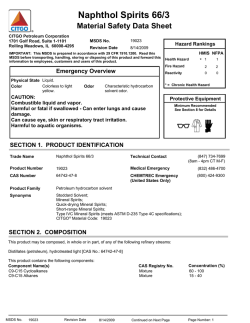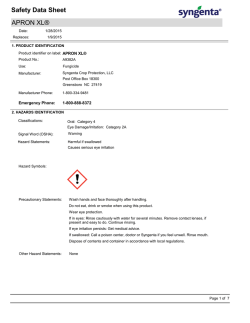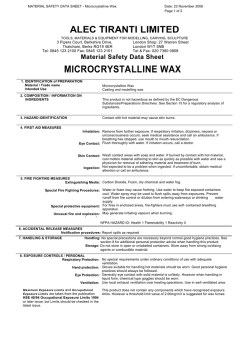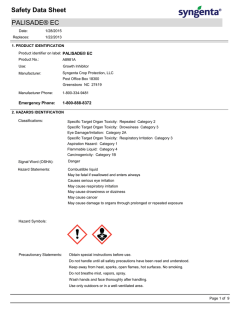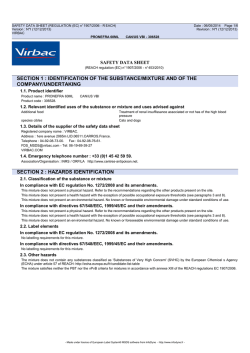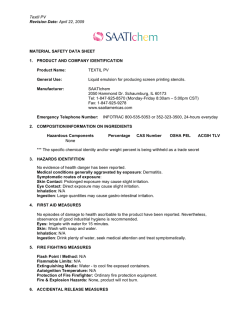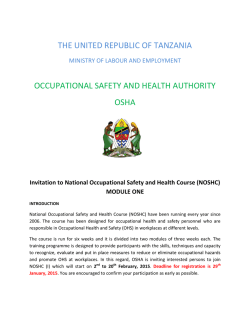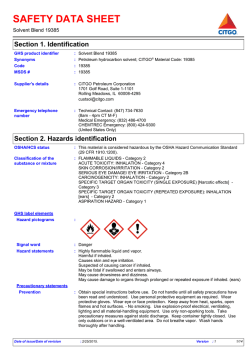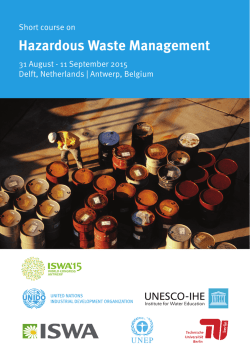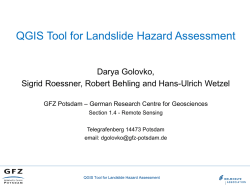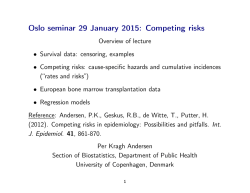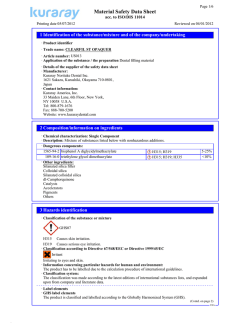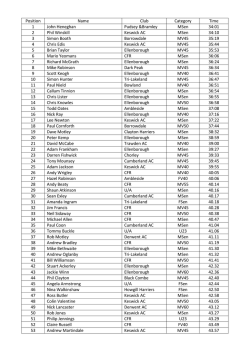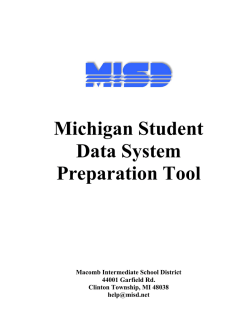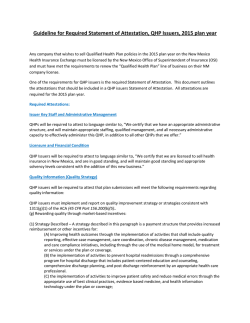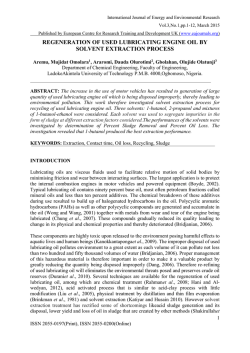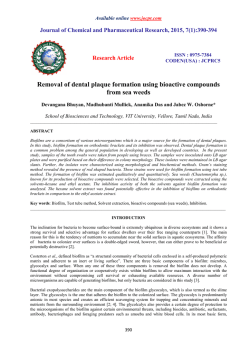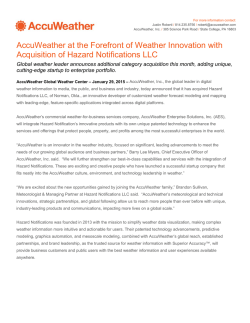
142 Solvent 66/3
142 Solvent 66/3
Material Safety Data Sheet
CITGO Petroleum Corporation
1701 Golf Road, Suite 1-1101
Rolling Meadows, IL 60008-4295
MSDS No.
19026
Revision Date
8/22/2012
IMPORTANT: This MSDS is prepared in accordance with 29 CFR 1910.1200. Read this
MSDS before transporting, handling, storing or disposing of this product and forward this
information to employees, customers and users of this product.
Emergency Overview
Physical State Liquid.
Transparent,
Color
colorless.
Odor
Characteristic hydrocarbon
solvent odor.
Hazard Rankings
HMIS NFPA
1
1
Fire Hazard
2
2
Reactivity
0
0
Health Hazard
*
* = Chronic Health Hazard
CAUTION:
Combustible liquid and vapor.
Harmful or fatal if swallowed - Can enter lungs and cause
damage.
Can cause eye, skin or respiratory tract irritation.
Harmful to aquatic organisms.
Protective Equipment
Minimum Recommended
See Section 8 for Details
SECTION 1. PRODUCT IDENTIFICATION
Trade Name
142 Solvent 66/3
Technical Contact
Product Number
19026
Medical Emergency
(832) 486-4700
CAS Number
64742-47-8
CHEMTREC Emergency
(United States Only)
(800) 424-9300
Product Family
Petroleum hydrocarbon solvent
Synonyms
Petroleum hydrocarbon solvent;
140 Flash Solvent;
High Flash Stoddard Solvent;
High-flash Mineral Spirits;
Type IIC Mineral Spirits (meets ASTM D-235 Type 2C specifications);
CITGO ® Material Code: 19026
(847) 734-7699
(8am - 4pm CT M-F)
SECTION 2. COMPOSITION
This product may be composed, in whole or in part, of any of the following refinery streams:
Distillates (petroleum), hydrotreated light [CAS No.: 64742-47-8]
This product contains the following components:
Component Name(s)
C9-C15 Cycloalkanes
C9-C15 Alkanes
MSDS No.
19026
Revision Date
CAS Registry No.
Mixture
Mixture
8/22/2012
Continued on Next Page
Concentration (%)
60 - 100
10 - 30
Page Number: 1
142 Solvent 66/3
SECTION 3. HAZARDS IDENTIFICATION
Also see Emergency Overview and Hazard Ratings on the top of Page 1 of this MSDS.
Major Route(s) of Entry Skin contact. Eye contact. Inhalation. Ingestion.
Signs and Symptoms of Acute Exposure
Inhalation
Breathing high concentrations may be harmful. Mist or vapor can irritate the throat and lungs.
Breathing this material may cause central nervous system depression with symptoms
including nausea, headache, dizziness, fatigue, drowsiness, or unconsciousness. Intentional
misuse by deliberately concentrating and inhaling this product may be harmful or fatal.
Eye Contact
This product can cause transient mild eye irritation with short-term contact with liquid sprays
or mists. Symptoms include stinging, watering, redness, and swelling.
Skin Contact
This product can cause mild, transient skin irritation. The severity of irritation will depend on
the amount of material that is applied to the skin and the speed and thoroughness that it is
removed. Symptoms include redness, itching, and burning of the skin. Repeated or
prolonged skin contact can produce moderate irritation (dermatitis).
Ingestion
If swallowed, this material may irritate the mucous membranes of the mouth, throat, and
esophagus. It can be readily absorbed by the stomach and intestinal tract. Symptoms
include a burning sensation of the mouth and esophagus, nausea, vomiting, dizziness,
staggering gait, drowsiness, loss of consciousness, and delirium, as well as additional
central nervous system (CNS) effects. Due to its light viscosity, there is a danger of
aspiration into the lungs during vomiting. Aspiration can result in severe lung damage or
death.
Chronic Health Effects Chronic effects of ingestion and subsequent aspiration into the lungs may cause
pneumatocele (lung cavity) formation and chronic lung dysfunction.
Summary
Reports have associated repeated and prolonged occupational overexposure to solvents with
irreversible brain and nervous system damage (sometimes referred to as "Solvent or
Painter's Syndrome").
Conditions Aggravated Disorders of the following organs or organ systems that may be aggravated by significant
exposure to this material or its components include: Skin, Respiratory System, Liver,
by Exposure
Kidneys, Central Nervous System (CNS)
Target Organs
May cause damage to the following organs: kidneys, lungs, liver, mucous membranes, upper
respiratory tract, skin, central nervous system (CNS), eye, lens or cornea
Carcinogenic Potential This product is not known to contain any components at concentrations above 0.1% which
are considered carcinogenic by OSHA, IARC or NTP.
OSHA Hazard Classification is indicated by an "X" in the box adjacent to the hazard title. If no "X" is present,
the product does not exhibit the hazard as defined in the OSHA Hazard Communication Standard (29 CFR
1910.1200).
OSHA Physical Hazard Classification
OSHA Health Hazard Classification
Irritant
Sensitizer
Combustible
Toxic
Highly Toxic
Corrosive
Carcinogenic
MSDS No.
19026
Revision Date
Explosive
Pyrophoric
Flammable
Oxidizer
Water-reactive
Compressed Gas
Organic Peroxide
Unstable
8/22/2012
X
Continued on Next Page
Page Number: 2
142 Solvent 66/3
SECTION 4. FIRST AID MEASURES
Take proper precautions to ensure your own health and safety before attempting rescue or providing first aid.
For more specific information, refer to Exposure Controls and Personal Protection in Section 8 of this MSDS.
Inhalation
Immediately move victim to fresh air. If victim is not breathing, immediately begin rescue
breathing. If heart has stopped, immediately begin cardiopulmonary resuscitation (CPR). If
breathing is difficult, 100 percent humidified oxygen should be administered by a qualified
individual. Seek medical attention immediately.
Eye Contact
Flush eyes with cool, clean, low-pressure water for at least 15 minutes. Hold eyelids apart to
ensure complete irrigation of the eye and eyelid tissue. If easily accomplished, check for and
remove contact lenses. If contact lenses cannot be removed, seek immediate medical
attention. Do not use eye ointment. Seek medical attention.
Skin Contact
Remove contaminated shoes and clothing. Flush affected area with large amounts of water.
If skin surface is damaged, apply a clean dressing and seek medical attention. Do not use
ointments. If skin surface is not damaged, clean affected area thoroughly with mild soap and
water. Seek medical attention if tissue appears damaged or if pain or irritation persists.
Ingestion
Do not induce vomiting. If spontaneous vomiting is about to occur, place victim’s head below
knees. If victim is drowsy or unconscious, place on the left side with head down. Never give
anything by mouth to a person who is not fully conscious. Do not leave victim unattended.
Seek medical attention immediately.
Notes to Physician
INHALATION: Inhalation overexposure can produce toxic effects. Monitor for respiratory
distress. If cough or difficulty in breathing develops, evaluate for upper respiratory tract
inflammation, bronchitis, and pneumonitis. Administer supplemental oxygen with assisted
ventilation, as required.
INGESTION: If ingested, this material presents a significant aspiration and chemical
pneumonitis hazard. Induction of emesis is not recommended. Consider activated charcoal
and/or gastric lavage. If patient is obtunded, protect the airway by cuffed endotracheal
intubation or by placement of the body in a Trendelenburg and left lateral decubitus position.
SECTION 5. FIRE FIGHTING MEASURES
NFPA Flammability
Classification
NFPA Class-IIIA combustible liquid.
Flash Point
Closed cup: 66°C (150°F). (Tagliabue (ASTM D-56))
Upper Flammable Limit AP 6 %
Lower Flammable Limit AP 0.8 %
Autoignition
Temperature
Not available.
Hazardous Combustion Carbon dioxide, carbon monoxide, smoke, fumes, and/or unburned hydrocarbons.
Products
Special Properties
Combustible Liquid! This material releases vapors when heated above ambient
temperatures. Vapors can cause a flash fire. Vapors can travel to a source of ignition and
flashback. A vapor and air mixture can create an explosion hazard in confined spaces such
as sewers. Use only with adequate ventilation. If container is not properly cooled, it can
rupture in the heat of a fire.
Extinguishing Media
SMALL FIRE: Use dry chemicals, carbon dioxide, foam, or inert gas (nitrogen). Carbon
dioxide and inert gas can displace oxygen. Use caution when applying carbon dioxide or
inert gas in confined spaces.
LARGE FIRE: Use foam, water fog, or water spray. Water fog and spray are effective in
cooling containers and adjacent structures. However, water can cause frothing and/or may
not extinguish the fire. Water can be used to cool the external walls of vessels to prevent
excessive pressure, autoignition or explosion. DO NOT use a solid stream of water directly
on the fire as the water may spread the fire to a larger area.
MSDS No.
19026
Revision Date
8/22/2012
Continued on Next Page
Page Number: 3
142 Solvent 66/3
Protection of Fire
Fighters
Firefighters must use full bunker gear including NIOSH-approved positive pressure
self-contained breathing apparatus to protect against potential hazardous combustion or
decomposition products and oxygen deficiencies. Evacuate area and fight the fire from a
maximum distance or use unmanned hose holders or monitor nozzles. Cover pooling liquid
with foam. Containers can build pressure if exposed to radiant heat; cool adjacent containers
with flooding quantities of water until well after the fire is out. Withdraw immediately from the
area if there is a rising sound from a venting safety device or discoloration of vessels, tanks,
or pipelines. Be aware that burning liquid will float on water. Notify appropriate authorities of
potential fire and explosion hazard if liquid enter sewers or waterways.
SECTION 6. ACCIDENTAL RELEASE MEASURES
Take proper precautions to ensure your own health and safety before attempting spill control or clean-up. For
more specific information, refer to the Emergency Overview on Page 1, Exposure Controls and Personal
Protection in Section 8 and Disposal Considerations in Section 13 of this MSDS.
Combustible Liquid! Release causes an immediate fire or explosion hazard. Evacuate all
non-essential personnel from immediate area and establish a "regulated zone" with site
control and security. A vapor-suppressing foam may be used to reduce vapors. Eliminate all
ignition sources. All equipment used when handling this material must be grounded. Stop the
leak if it can done without risk. Do not touch or walk through spilled material. Remove
spillage immediately from hard, smooth walking areas. Prevent its entry into waterways,
sewers, basements, or confined areas. Absorb or cover with dry earth, sand, or other
non-combustible material and transfer to appropriate waste containers. Use clean,
non-sparking tools to collect absorbed material.
For large spills, secure the area and control access. Dike far ahead of a liquid spill to ensure
complete collection. Water mist or spray may be used to reduce or disperse vapors; but, it
may not prevent ignition in closed spaces. This material will float on water and its run-off may
create an explosion or fire hazard. Verify that responders are properly HAZWOPER-trained
and wearing appropriate respiratory equipment and fire-resistant protective clothing during
cleanup operations. In an urban area, cleanup spill as soon as possible; in natural
environments, cleanup on advice from specialists. Pick up free liquid for recycle and/or
disposal if it can be accomplished safely with explosion-proof equipment. Collect any excess
material with absorbant pads, sand, or other inert non-combustible absorbent materials.
Place into appropriate waste containers for later disposal. Comply with all laws and
regulations.
SECTION 7. HANDLING AND STORAGE
A spill or leak can cause an immediate fire or explosion hazard. Keep containers closed and
do not handle or store near heat, sparks, or any other potential ignition sources. Avoid
contact with oxidizing agents. Do NOT breathe vapor. Use only with adequate ventilation and
personal protection. Never siphon by mouth. Avoid contact with eyes, skin, and clothing.
Prevent contact with food and tobacco products. Do NOT take internally.
Handling
When performing repairs and maintenance on contaminated equipment, keep unnecessary
persons away from the area. Eliminate all potential ignition sources. Drain and purge
equipment, as necessary, to remove material residues. Follow proper entry procedures,
including compliance with 29 CFR 1910.146 prior to entering confined spaces such as tanks
or pits. Use gloves constructed of impervious materials and protective clothing if direct
contact is anticipated. Use appropriate respiratory protection when concentrations exceed
any established occupational exposure level (See Section 8) Promptly remove contaminated
clothing. Wash exposed skin thoroughly with soap and water after handling.
Non-equilibrium conditions may increase the fire hazard associated with this product. A
static electrical charge can accumulate when this material is flowing through pipes, nozzles or
filters and when it is agitated. A static spark discharge can ignite accumulated vapors
particularly during dry weather conditions. Always bond receiving containers to the fill pipe
before and during loading. Always confirm that receiving container is properly grounded.
Bonding and grounding alone may be inadequate to eliminate fire and explosion hazards
MSDS No.
19026
Revision Date
8/22/2012
Continued on Next Page
Page Number: 4
142 Solvent 66/3
associated with electrostatic charges. Carefully review operations that may increase the risks
associated with static electricity such as tank and container filling, tank cleaning, sampling,
gauging, loading, filtering, mixing, agitation, etc. In addition to bonding and grounding, efforts
to mitigate the hazards of an electrostatic discharge may include, but are not limited to,
ventilation, inerting and/or reduction of transfer velocities. Dissipation of electrostatic charges
may be improved with the use of conductivity additives when used with other mitigation
efforts, including bonding and grounding. Always keep nozzle in contact with the container
throughout the loading process.
Do NOT fill any portable container in or on a vehicle. Do NOT use compressed air for filling,
discharging or other handling operations. Product container is NOT designed for elevated
pressure. Do NOT pressurize, cut, weld, braze solder, drill, or grind on containers. Do NOT
expose product containers to flames, sparks, heat or other potential ignition sources. Empty
containers may contain material residues which can ignite with explosive force. Observe label
precautions.
Keep container tightly closed. Store in a cool, dry, well-ventilated area. Store only in
approved containers. Do not store with oxidizing agents. Do not store at elevated
temperatures or in direct sunlight. Protect containers against physical damage. Head spaces
in tanks and other containers may contain a mixture of air and vapor in the flammable range.
Vapor may be ignited by static discharge. Storage area must meet OSHA requirements and
applicable fire codes. Additional information regarding the design and control of hazards
associated with the handling and storage of flammable and combustible liquids may be found
in professional and industrial documents including, but not limited to, the National Fire
Protection Association (NFPA) publications NFPA 30 ("Flammable and Combustible Liquid
Code"), NFPA 77 ("Recommended Practice on Static Electricity") and the American
Petroleum Institute (API) Recommended Practice 2003, (“Protection Against Ignitions Arising
Out of Static, Lightning, and Stray Currents").
Storage
Consult appropriate federal, state and local authorities before reusing, reconditioning,
reclaiming, recycling or disposing of empty containers or waste residues of this product.
SECTION 8. EXPOSURE CONTROLS AND PERSONAL PROTECTION
Engineering Controls
Provide ventilation or other engineering controls to keep the airborne concentrations of
vapor or mists below the applicable workplace exposure limits indicated below. All electrical
equipment should comply with the National Electrical Code. An emergency eye wash station
and safety shower should be located near the work-station.
Personal Protective
Equipment
Personal protective equipment should be selected based upon the conditions under which
this material is used. A hazard assessment of the work area for PPE requirements should
be conducted by a qualified professional pursuant to OSHA regulations. The following
pictograms represent the minimum requirements for personal protective equipment. For
certain operations, additional PPE may be required.
Eye Protection
Safety glasses equipped with side shields are recommended as minimum protection in
industrial settings. Chemical goggles should be worn during transfer operations or when
there is a likelihood of misting, splashing, or spraying of this material. A suitable emergency
eye wash water and safety shower should be located near the work station.
Hand Protection
Avoid skin contact. Use heavy duty gloves constructed of chemical resistant materials such
as Viton® or heavy nitrile rubber. Wash hands with plenty of mild soap and water before
eating, drinking, smoking, use of toilet facilities or leaving work. DO NOT use gasoline,
kerosene, solvents or harsh abrasives as skin cleaners.
MSDS No.
19026
Revision Date
8/22/2012
Continued on Next Page
Page Number: 5
142 Solvent 66/3
Avoid skin contact. Wear long-sleeved fire-retardant garments (e.g., Nomex®) while
working with flammable and combustible liquids. Additional chemical-resistant protective
gear may be required if splashing or spraying conditions exist. This may include an apron,
boots and additional facial protection. If product comes in contact with clothing, immediately
remove soaked clothing and shower. Promptly remove and discard contaminated leather
goods.
Body Protection
Respiratory Protection For known vapor concentrations above the occupational exposure guidelines (see below),
use a NIOSH-approved organic vapor respirator if adequate protection is provided.
Protection factors vary depending upon the type of respirator used. Respirators should be
used in accordance with OSHA requirements (29 CFR 1910.134). For airborne vapor
concentrations that exceed the recommended protection factors for organic vapor
respirators, use a full-face, positive-pressure, supplied air respirator. Due to fire and
explosion hazards, do not enter atmospheres containing concentrations greater than 10% of
the lower flammable limit of this product.
General Comments
Warning! Use of this material in spaces without adequate ventilation may result in
generation of hazardous levels of flammable vapors and/or inadequate oxygen levels for
breathing. Odor is an inadequate warning for hazardous conditions.
Occupational Exposure Guidelines
Substance
142 Solvent
Applicable Workplace Exposure Levels
ACGIH TLV (United States).
TWA: 179 ppm (1200 mg/M 3) 8 hour(s).
Notes: The TLV for the hydrocarbon solvent is based on the
procedure described in Appendix H ("Reciprocal Calculations Method
for Certain Refined Hydrocarbon Solvent Vapors") of the ACGIH TLVs
® and BEIs® guidelines. The GGV mixture (ACGIH TLV) is based on
Column B (McKee et al., 2005) of Table 1 ("Group Guidance Values")
of Appendix H.
ACGIH (United States).
TWA: 100 ppm
OSHA (United States).
TWA: 500 ppm
Petroleum Hydrocarbon Distillates
SECTION 9. PHYSICAL AND CHEMICAL PROPERTIES (TYPICAL)
Characteristic hydrocarbon
solvent odor.
>1 (Air = 1)
Physical State
Liquid.
Color
Transparent,
colorless.
Odor
Specific Gravity
0.794 (Water = 1)
pH
Not applicable
Vapor
Density
Boiling Range
192 to 205°C (378 to 401°F)
Melting/Freezing
Point
Not available.
Vapor Pressure
0.07 kPa (0.5 mm Hg) (at 20°C)
0.27 torr at 20°C (68°F) by Isoteniscope
(ASTM D-2879).
Volatility
794 g/l VOC (w/v)
Solubility in
Water
Very slightly soluble in cold water. (<0.1 %
w/w)
Viscosity
(cSt @ 40°C)
Not available.
Flash Point
Closed cup: 66°C (150°F). (Tagliabue (ASTM D-56))
Additional
Properties
Conductivity = <5 picosiemens/meter (unadditized)
MSDS No.
19026
Revision Date
8/22/2012
Continued on Next Page
Page Number: 6
142 Solvent 66/3
SECTION 10. STABILITY AND REACTIVITY
Hazardous Polymerization Not expected to occur.
Chemical Stability
Stable.
Conditions to Avoid
Keep away from heat, flame and other potential ignition sources. Keep away from strong
oxidizing conditions and agents.
Materials
Incompatibility
Strong acids, alkalies, and oxidizers such as liquid chlorine and oxygen.
Hazardous
Decomposition
Products
No additional hazardous decomposition products were identified other than the combustion
products identified in Section 5 of this MSDS.
SECTION 11. TOXICOLOGICAL INFORMATION
For other health-related information, refer to the Emergency Overview on Page 1 and the Hazards Identification
in Section 3 of this MSDS.
Toxicity Data
:
Distillates (petroleum), hydrotreated light
ORAL (LD50):
Acute: >5000 mg/kg [Rat].
DERMAL (LD50):
Acute: >2000 mg/kg [Rabbit].
IRRITATION:
Primary dermal irritation studies (four hour exposure) in rabbits utilizing mineral spirits
containing less than 2% aromatics resulted in slight to moderate skin irritation. In humans,
mineral spirits have produced slight to moderate skin irritation particularly with evaporation
from the skin is prevented. Animal studies have demonstrated that mineral spirits produced
mild respiratory tract irritation at elevated concentrations. Also, sensory respiratory tract
irritation was evident by reduced breathing rates in the test animals in certain studies.
SENSITIZATION:
In animal studies utilizing mineral spirits containing up to 18%, aromatics skin sensitization is
not evident.
REPEAT DOSE/TARGET ORGAN TOXICITY:
The most common effects observed in repeated dose animal studies with mineral spirits are
kidney changes that are consistent with an alpha 2u-globulin- mediated process that is not
regarded as relevant to humans. The kidney damage occurred only in male rats and
appeared to involve both the tubules and glomeruli. Certain studies have reported effects in
the liver as well as hematological or urine chemistry changes. In general, these effects have
not to been shown to be dose-related.
NERVOUS SYSTEM EFFECTS:
In animal studies utilizing mineral spirits containing up to 22% aromatics indicated that the
acute central nervous system effects are reversible. Based on existing animal studies, the
potential for persistent effects is not clear. In certain repeated dose animal studies have
changes were reported in behavior, neurochemistry and sensory evoked potentials which
may be irreversible. Repeated exposure to elevated concentrations of hydrocarbon solvents
can produce a variety of transient CNS effects (e.g., dizziness, headache, narcosis, etc).
REPRODUCTIVE/DEVELOPMENTAL TOXICITY:
There were no treatment-related effects on pregnancy rate, mortality or gross post mortem
observations in animal studies utilizing mineral spirits containing less than 2% aromatics.
GENOTOXICITY:
In vivo and in vitro studies on mineral spirits containing up to 22 % aromatics indicate that
these products are not genotoxic.
CARCINOGENICITY:
The National Toxicology Program (NTP) conducted two-year carcinogenicity studies in rats
and mice with Stoddard Solvent IIC (less than 2% aromatics). The studies indicated that there
was some evidence of carcinogenic activity in male rats (adrenal medulla neoplasms and
renal tubule adenoma) but no evidence of carcinogenic activity in female rats. Further, there
was equivocal evidence of carcinogenic activity in female mice (hepatocellular adenoma) but
no evidence of carcinogenic activity in male mice. A low carcinogenic potential is suggested
MSDS No.
19026
Revision Date
8/22/2012
Continued on Next Page
Page Number: 7
142 Solvent 66/3
by a lack of genotoxic potential identified in in vivo and in vitro genetic toxicity tests (with and
without metabolic activation).
SECTION 12. ECOLOGICAL INFORMATION
Ecotoxicity
This mixture contains components that are potentially toxic to freshwater and saltwater
ecosystems.
Environmental Fate
This product will normally float on water. Components will evaporate rapidly. This material
may be harmful to aquatic organisms and may cause long term adverse effects in the aquatic
environment. The octanol-water partition coefficient (log Kow) for this product is expected to
be in the range of 2.1 to 5.
SECTION 13. DISPOSAL CONSIDERATIONS
Hazard characteristic and regulatory waste stream classification can change with product use. Accordingly, it is
the responsibility of the user to determine the proper storage, transportation, treatment and/or disposal
methodologies for spent materials and residues at the time of disposition.
Conditions of use may cause this material to become a "hazardous waste", as defined by
federal or state regulations. It is the responsibility of the user to determine if the material is a
RCRA "hazardous waste" at the time of disposal. Transportation, treatment, storage and
disposal of waste material must be conducted in accordance with RCRA regulations (see 40
CFR 260 through 40 CFR 271). State and/or local regulations may be more restrictive.
Contact your regional US EPA office for guidance concerning case specfic disposal issues.
SECTION 14. TRANSPORT INFORMATION
The shipping description below may not represent requirements for all modes of transportation, shipping
methods or locations outside of the United States.
A U.S. Department of Transportation (DOT) regulated material.
US DOT Status
Proper Shipping Name UN1268, Petroleum Distillates, n.o.s., Combustible Liquid, PG III
[This product has a flash point temperature between 60.5° to 93°C (141° and 200°F). Bulk
shipments of this product are regulated.]
Combustible liquid.
Combustible liquid
Packing Group
Hazard Class
UN/NA Number
Reportable Quantity
A Reportable Quantity (RQ) has not been established for this material.
Placard(s)
MSDS No.
19026
UN 1268
Revision Date
8/22/2012
Emergency Response
Guide No.
128
MARPOL III Status
Not a DOT "Marine
Pollutant" per 49 CFR
171.8.
Continued on Next Page
Page Number: 8
142 Solvent 66/3
SECTION 15. REGULATORY INFORMATION
TSCA Inventory
This product and/or its components are listed on the Toxic Substances Control Act (TSCA)
inventory.
SARA 302/304
Emergency Planning
and Notification
The Superfund Amendments and Reauthorization Act of 1986 (SARA) Title III requires
facilities subject to Subparts 302 and 304 to submit emergency planning and notification
information based on Threshold Planning Quantities (TPQs) and Reportable Quantities
(RQs) for "Extremely Hazardous Substances" listed in 40 CFR 302.4 and 40 CFR 355. No
components were identified.
SARA 311/312 Hazard
Identification
The Superfund Amendments and Reauthorization Act of 1986 (SARA) Title III requires
facilities subject to this subpart to submit aggregate information on chemicals by "Hazard
Category" as defined in 40 CFR 370.2. This material would be classified under the following
hazard categories:
Fire, Acute (Immediate) Health Hazard, Chronic (Delayed) Health Hazard
This product contains the following components in concentrations above de minimis levels
SARA 313 Toxic
Chemical Notification that are listed as toxic chemicals in 40 CFR Part 372 pursuant to the requirements of Section
and Release Reporting 313 of SARA: No components were identified.
CERCLA
The Comprehensive Environmental Response, Compensation, and Liability Act of 1980
(CERCLA) requires notification of the National Response Center concerning release of
quantities of "hazardous substances" equal to or greater than the reportable quantities (RQ's)
listed in 40 CFR 302.4. As defined by CERCLA, the term "hazardous substance" does not
include petroleum, including crude oil or any fraction thereof which is not otherwise
specifically designated in 40 CFR 302.4. This product or refinery stream is not known to
contain chemical substances subject to this statute. However, it is recommended that you
contact state and local authorities to determine if there are any other reporting requirements
in the event of a spill.
Clean Water Act
(CWA)
This material is classified as an oil under Section 311 of the Clean Water Act (CWA) and the
Oil Pollution Act of 1990 (OPA). Discharges or spills which produce a visible sheen on waters
of the United States, their adjoining shorelines, or into conduits leading to surface waters must
be reported to the EPA's National Response Center at (800) 424-8802.
California
Proposition 65
This material may contain the following components which are known to the State of California
to cause cancer, birth defects or other reproductive harm, and may be subject to the
requirements of California Proposition 65 (CA Health & Safety Code Section 25249.5):
Naphthalene: <0.001%
Ethylbenzene: <0.001%
Toluene: <0.0001%
New Jersey
Right-to-Know Label
For New Jersey R-T-K labeling requirements, refer to components listed in Section 2.
Additional Remarks
Federal Hazardous Substances Act, related statutes, and Consumer Product Safety
Commission regulations, as defined by 16 CFR 1500.14(b)(3) and 1500.83(a)(13): This
product contains "Petroleum Distillates" which may require special labeling if distributed in a
manner intended or packaged in a form suitable for use in the household or by children.
Precautionary label dialogue should display the following: DANGER: Contains Petroleum
Distillates! Harmful or fatal if swallowed! Call Physician Immediately. KEEP OUT OF
REACH OF CHILDREN!
MSDS No.
19026
Revision Date
8/22/2012
Continued on Next Page
Page Number: 9
142 Solvent 66/3
SECTION 16. OTHER INFORMATION
Refer to the top of Page 1 for the HMIS and NFPA Hazard Ratings for this product.
REVISION INFORMATION
6.2
8/22/2012
ABBREVIATIONS
Version Number
Revision Date
AP: Approximately
EQ: Equal
>: Greater Than
NA: Not Applicable
ND: No Data
NE: Not Established
<: Less Than
ACGIH: American Conference of Governmental Industrial Hygienists
AIHA: American Industrial Hygiene Association
IARC: International Agency for Research on Cancer
NIOSH: National Institute of Occupational Safety and Health
NPCA: National Paint and Coating Manufacturers Association
EPA: US Environmental Protection Agency
HMIS: Hazardous Materials Information System
OSHA: Occupational Safety and Health Administration
NTP: National Toxicology Program
NFPA: National Fire Protection Association
DISCLAIMER OF LIABILITY
THE INFORMATION IN THIS MSDS WAS OBTAINED FROM SOURCES WHICH WE BELIEVE ARE RELIABLE.
HOWEVER, THE INFORMATION IS PROVIDED WITHOUT ANY WARRANTY, EXPRESSED OR IMPLIED
REGARDING ITS CORRECTNESS. SOME INFORMATION PRESENTED AND CONCLUSIONS DRAWN HEREIN ARE
FROM SOURCES OTHER THAN DIRECT TEST DATA ON THE SUBSTANCE ITSELF. THIS MSDS WAS PREPARED
AND IS TO BE USED ONLY FOR THIS PRODUCT. IF THE PRODUCT IS USED AS A COMPONENT IN ANOTHER
PRODUCT, THIS MSDS INFORMATION MAY NOT BE APPLICABLE. USERS SHOULD MAKE THEIR OWN
INVESTIGATIONS TO DETERMINE THE SUITABILITY OF THE INFORMATION OR PRODUCTS FOR THEIR
PARTICULAR PURPOSE.
THE CONDITIONS OR METHODS OF HANDLING, STORAGE, USE, AND DISPOSAL OF THE PRODUCT ARE
BEYOND OUR CONTROL AND MAY BE BEYOND OUR KNOWLEDGE. FOR THIS AND OTHER REASONS, WE DO
NOT ASSUME RESPONSIBILITY AND EXPRESSLY DISCLAIM LIABILITY FOR LOSS, DAMAGE OR EXPENSE
ARISING OUT OF OR IN ANY WAY CONNECTED WITH HANDLING, STORAGE, USE OR DISPOSAL OF THE
PRODUCT.
*****
END OF MSDS
*****
© Copyright 2025
